Safety Protocols Every Concrete Machinery Operator Should Know
-
Thesis: Operating concrete machinery carries inherent risks; strict adherence to fundamental and machine-specific safety protocols is non-negotiable for preventing accidents and ensuring a safe jobsite.

-
Outline:
-
Universal Safety Foundations:
-
Training & Certification: Mandatory formal training (OEM, NCCCO for cranes/booms) and site-specific orientation. Never operate untrained.
-
PPE: Hard hat, high-vis vest, safety glasses, steel-toe boots, hearing protection, gloves (task-specific). Respirator for dust/silica.
-
Pre-Operational Inspection: Thorough walk-around check (fluids, leaks, tires/tracks, wear parts, safety devices, lights/horn, guards in place) documented daily.
-
Know the Machine: Read and understand the operator's manual. Know capacities, limitations, stability factors.
-
Clear Communication: Use standardized hand signals or radios. Establish clear zones.
-
-
Critical Machine-Specific Protocols:
-
Concrete Pumps (Boom & Line):
-
Stability is Paramount: Always use outriggers/stabilizers fully on stable ground as per manual. Use pads/cribbing. Never bypass safety systems.
-
Setup Clearance: Maintain safe distance from power lines (10ft + per KV is standard MINIMUM, consult regulations), excavations, overhangs.
-
Pipe Handling: Secure pipe connections. Use proper lifting techniques/equipment. Never stand under suspended pipe loads.
-
Hopper Safety: Never place hands/feet in hopper. Use tools to clear blockages ONLY when pump is OFF and energy is LOCKED OUT. Guarding must be intact.
-
Pressure Release: Understand safe procedures for releasing line pressure before disassembly.
-
-
Mixers (Drum & Volumetric):
-
Drum Rotation Hazard: Stay clear of rotating drum. Never clean or perform maintenance near rotating parts without LOTO.
-
Loading/Unloading: Ensure stable ground for trucks. Secure aggregate bins/cement silos.
-
Material Handling: Beware of falling aggregate, cement dust (silica hazard). Use dust collection.
-
*Electrical Safety (EVs): High-voltage protocols, designated charging areas.
-
-
Finishing Equipment (Trowels, Screeds):
-
Rotating Blades: Extreme hazard. Keep guards in place. Never operate on inclines exceeding manufacturer limits. Clear area of debris/hoses.
-
Electrical Hazards: Ensure cords/GFCIs are intact. Beware of wet conditions.
-
Slab Edges: Maintain safe distance to avoid falls.
-
-
Batching Plants: Lockout/Tagout (LOTO) for all maintenance. Beware of moving conveyors, falling material, high platforms. Dust control.

-
-
Site-Wide Considerations: Traffic management (spotters), trench/excavation awareness, overhead hazards, weather (wind for booms, lightning), emergency procedures.
-
Safety Culture: Management commitment, near-miss reporting, regular safety meetings, empowering operators to stop unsafe work. Safety is everyone's responsibility.
-
 Roll, Mix, Pour: Inside the Z
Roll, Mix, Pour: Inside the Z
 High-Efficiency in Action: How
High-Efficiency in Action: How
 Clean Lines, Smooth Pours: Zoo
Clean Lines, Smooth Pours: Zoo
 Master the Flow: A Step-by-St
Master the Flow: A Step-by-St
